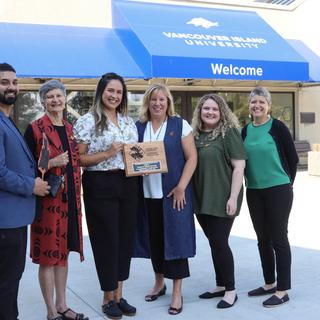By Kendra Stiwich, Director Graduate Studies and Student Research
“How many languages do you speak?” Invariably when I ask this to a room full of VIU graduate students there are always a couple who can speak more than five. I follow this with, “Well, you are about to start learning another - Hul’q’umi’num'.” We begin with saying some gentle words and phrases, Huy ch q’a (Thank you), Uy’ skweyul (Good Day), ‘Uy’ kwunus ‘i lumnamu (It is good to see you). For a crowd of new VIU students, many new to Canada – doing this as a group is powerful. The students don’t know it but in the first five minutes of this RockVIU workshop, I am already holding back tears just listening to a hundred people repeat with increasing confidence, “Huy ch q’a.” I explain how I am learning too.
I am not an Indigenous person to this part of the world. I was born and raised far away from Vancouver Island, on another Island called Epekwitk, more recently also known as Prince Edward Island. I identify as someone with ancestors who came to the eastern territories of what is currently Canada around 300 years ago. Colonists. Simple folk as they may have been, uneducated, poor. But white. And ruled by a crown. Crucial parts of the colonial legacy that remain in this country today.
One of the goals and learning outcomes of RockVIU is to promote understanding of Indigenous protocol and territory acknowledgements. However, how can we do this? How can I lean into this? Knowing you have a responsibility is one thing, understanding how to act is something else. So, I start with…
Truth
Originally called Colviletown, Nanaimo was renamed in 1860. The new name was a mispronunciation of Snuneymuxw, which means “gathering place of a great people.” Gathering place of a great people. Let that sink in folks. All of us who find ourselves here. Breath that in. How do we hold ourselves to this ideal of land and language? That is what I ask this room full of graduate students.
Then we walk through some more words and terms.
Reconciliation. Which leads me to the TRC and residential schools. I tell the story of how I graduated from a public highschool in Canada in 1996. The same year that the Gordon Reserve Indian Residential School in Saskatchewan, the last of its kind, closed. And back then, in 1996 graduating with honours, I had no idea that residential schools had EVER EXISTED. That’s part of my truth. Of what I need to work on to reconcile. The tears are harder to hold back now. But the crowd is listening.
We talk about the Calls to Action and how I use the time when I am preparing for this workshop to review all 94 of them. This year I specifically shared number sixty-three part three: “We call upon the Council of Ministers of Education, Canada to maintain an annual commitment to Aboriginal education issues, including: Building student capacity for intercultural understanding, empathy, and mutual respect.”
And that is our work today and tomorrow.
Then we unpack UNDRIP and consider how this is not just a VIU thing, a BC thing, a Canada thing. The United Nations has Declared the Rights of Indigenous Peoples. Plural. Global. ALL of us are part of this conversation. Perhaps the truths are different, but all those stories need a place to sit. A heart to listen.
Right around now, the room is just a little bit more ready to receive teachings about Protocol and Territorial Acknowledgements. How they are a sign of respect and recognition. How we are acknowledging the ties the descendants of those First People have to land, its importance to their culture, ceremonies, and traditions.
We talk about how introductions, as part of protocol, are not just a way to begin something like a meeting. They are integral to ongoing relationships that all the people in the room have with each other. Protocol imbues where we come from and who we are into the here and now. It signals our relations. This is a powerful statement for students who are in a new place and may feel like they have no relations. I tell them it is vitally important that they bring their relations into this place, that those relations make us who we are, they imbue place with an even greater richness. It tells this gathering place of all the great people who have come together. I like to think it makes Snuneymuxw smile and feel happy.
Then we break for lunch, because deep learning needs food.
And by this point I need to look up at the trees, listen to the birds, feel the breeze, and utter a deep and grateful, Huy tseep q’u.





